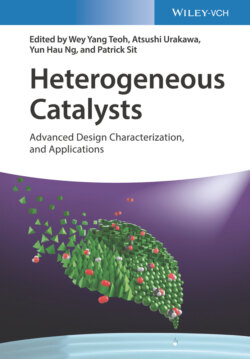Читать книгу Heterogeneous Catalysts - Группа авторов - Страница 57
4.3.3 Immobilization of Metal Clusters and SACs by Organometallic Approach
ОглавлениеMixed‐metal clusters modified with appropriate ligands can be immobilized onto CNTs and graphene using covalent or noncovalent π–π interactions [45] (see Chapter 5 on metal clusters synthesis). Subsequent removal of the stabilizing ligand by thermal treatment may lead to a different extent of coalescence, which depending on the exposed temperatures can result in carbon‐supported nanoparticles.
When the preparation of SACs on carbon is sought, an interesting approach is to use organometallic precursors containing both the dopant element such as nitrogen and the metal. Macrocyclic complexes bearing transition‐metal atoms similar to porphyrins, which contain both the dopant element and the metal, are excellent precursors to CUS or SACs. These macrocycles are noncovalently bound on graphitic materials by π–π stacking. The covalent anchoring of these macrocycles on carbon lattice upon pyrolysis is favored by the affinity of nitrogen atom for carbon materials. This will pave the way for stabilizing the catalyst under different solvents and under severe reaction conditions. Several macrocyclic molecules containing both metal and nitrogen atoms such as iron porphyrin or macrocycles formed by mixing phenanthroline or 2,2‐bipyridine and Fe salt have been used to prepare atomically dispersed Fe–Nx species on different carbon materials. Figure 4.6 shows some macrocycles used as precursors of single‐atom metal–Nx species on carbon materials. The special ligand endows the metal with the electronic density necessary to perform a reaction selectively suppressing undesired collateral reactions. The catalysts prepared have shown high activity in ORR comparable to Pt catalyst with high selectivity in the four‐electron reduction.
Figure 4.7 Different precursors to prepare nitrogen‐coordinated SACs. (a) Iron porphyrin, (b) iron phthalocyanine, (c) phenanthroline + Fe salt, and (d) 2,2‐bipyridine + Fe salt.
